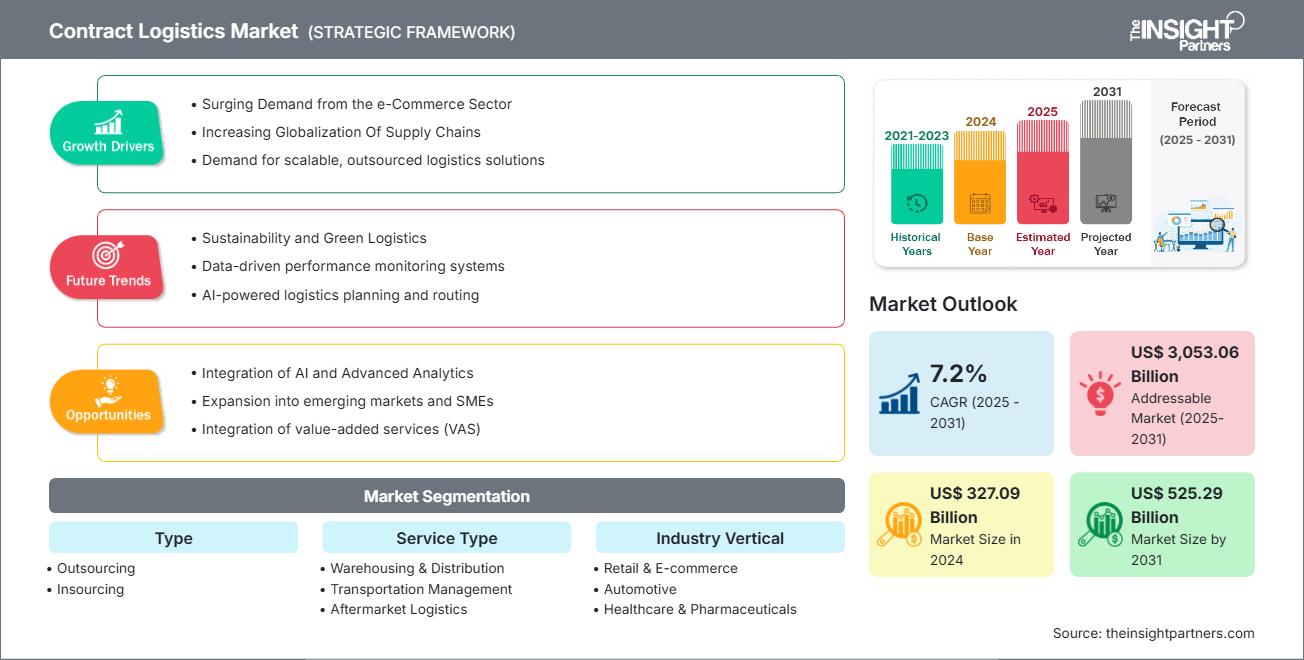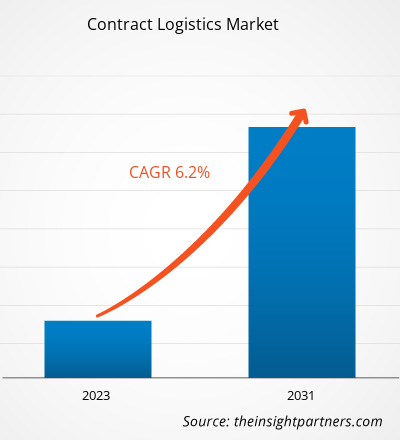契約物流市場規模は、2024年の3,270.9億米ドルから2031年には5,252.9億米ドルに達すると予想されています。市場は2025年から2031年の間に7.2%のCAGRを記録すると予想されています。
契約物流市場分析
契約物流市場は、eコマースの急速な成長、効率的なサプライチェーンソリューションへの需要の高まり、そして高度な物流ネットワークを必要とする貿易のグローバル化など、いくつかの主要な要因によって推進されています。自動化、IoT、AIといった技術の進歩は、物流業務の可視性、スピード、そして正確性を向上させ、大きな成長機会を生み出しています。さらに、企業は持続可能性への関心を高めており、物流事業者は環境に配慮した取り組みを導入し、市場の潜在力を拡大しようとしています。
契約物流市場の概要
契約ロジスティクスとは、倉庫保管、輸送、在庫管理、配送を顧客に代わって管理するサードパーティプロバイダーに、ロジスティクスおよびサプライチェーン管理サービスをアウトソーシングすることを指します。この契約により、企業はコスト効率、拡張性の向上、高度な物流技術と専門知識へのアクセスといったメリットを享受しながら、コアコンピテンシーに集中することができます。契約ロジスティクスの一般的な用途には、小売、製造、自動車、医薬品、eコマースなどにおける受注処理、貨物輸送、リバースロジスティクス、在庫管理などがあります。契約ロジスティクスサービスの種類は、単純な輸送・倉庫保管ソリューションから、梱包、組立、カスタマイズ配送などの付加価値サービスを含む統合型エンドツーエンドサプライチェーン管理まで多岐にわたります。
このレポートの一部、国レベルの分析、Excelデータパックなど、あらゆるレポートを無料でカスタマイズできます。また、スタートアップや大学向けのお得なオファーや割引もご利用いただけます。
契約物流市場:戦略的洞察

-
このレポートの主要な市場動向を入手してください。この無料サンプルには、市場動向から見積もりや予測に至るまでのデータ分析が含まれます。
契約物流市場の推進要因と機会
市場の推進要因:
-
電子商取引分野からの需要の急増:
電子商取引の急速な拡大は、契約物流市場の成長を大きく促進しています。より多くの消費者がオンラインショッピングに移行するにつれて、企業はより迅速で効率的な配送およびフルフィルメントサービスの需要の高まりに直面しています。この急増により、企業はサプライチェーン、倉庫保管、輸送、ラストマイル配送の管理を専門とするサードパーティプロバイダーに物流業務をアウトソーシングするようになりました。世界中で電子商取引が拡大しています。たとえば、2023年には、インドの電子商取引の状況は大きな発展を遂げました。デジタルコマースのためのオープンネットワーク(ONDC)は、11月のディワリ週に約120万件の取引を記録し、デジタルコマース活動の急増を反映しています。2023年12月までに、ONDCは1か月で550万件の取引を達成し、そのうち210万件は小売カテゴリーで達成され、デジタルプラットフォームの採用の増加を示しています。
-
サプライチェーンのグローバル化の進展
サプライチェーンのグローバル化の拡大は、契約物流市場の成長を促進する重要な要因です。企業が複数の国にまたがって原材料を調達し、製品を製造することが増えるにつれて、これらの分散した業務を管理する複雑さが大幅に増大しています。世界市場間の相互接続の拡大により、より効率的で柔軟性が高く、専門的な物流ソリューションが求められています。契約物流プロバイダーは、国際輸送、通関規制、多様な流通ネットワークに関連する課題を企業が乗り越えるのを支援する上で重要な役割を果たしています。2023年6月、米国商務省はサプライチェーン競争力に関する諮問委員会(ACSCC)を立ち上げ、関係当局者と業界リーダーを集め、越境物流、調達の多様化、インフラギャップなど、アウトソーシングされた物流能力への依存を高める重要な要因に関する調整について議論しました。
市場機会:
-
持続可能性とグリーン物流:
持続可能性とグリーンロジスティクスは、サプライチェーン業務を環境・社会ガバナンス(ESG)目標と整合させることで、契約ロジスティクス市場に大きなビジネスチャンスをもたらします。世界中の企業が二酸化炭素排出量の削減と環境に配慮した事業慣行の導入を求める圧力が高まる中、契約ロジスティクスプロバイダーは、環境への影響を軽減しながら業務効率を向上させる革新的なソリューションを生み出しています。これらのグリーンロジスティクス戦略は、排出量の最小化、輸送ルートの合理化、倉庫のエネルギー効率の向上、再生可能エネルギー源の統合に重点を置いています。これらの取り組みを推進することで、企業は世界的な持続可能性目標の達成に貢献し、長期的なレジリエンスと競争力を強化することができます。
契約物流市場レポートのセグメンテーション分析
契約物流市場は、その構造、成長見通し、そして新たなトレンドを包括的に理解できるよう、明確なセグメントに分類されています。以下は、ほとんどの業界レポートで使用されている標準的なセグメンテーション手法です。
タイプ別:
-
アウトソーシング:
契約物流におけるアウトソーシングとは、企業が倉庫保管、輸送、在庫管理、受注処理といったサプライチェーンおよび物流業務をサードパーティ・ロジスティクス(3PL)プロバイダーに委託することを指します。このセグメントは、2024年に契約物流市場で最大のシェアを占めました。 -
インソーシング:
契約物流におけるインソーシングとは、これまでアウトソーシングしていた物流業務を社内で再編することで、管理、効率性、そしてサービスのカスタマイズ性を向上させることです。世界的なサプライチェーンの混乱の中で、企業がより高い柔軟性を求める中で、この傾向はますます広がっています。
サービスタイプ別:
-
倉庫保管および配送:
倉庫保管と配送はコントラクト・ロジスティクスの中核を成す要素であり、効率的な在庫管理とタイムリーな製品移動を通じて企業のサプライチェーンを合理化することを可能にします。このセグメントは2024年にコントラクト・ロジスティクス市場で最大のシェアを獲得しました。
-
輸送管理:
輸送管理は契約物流の中核を成す要素であり、サプライチェーン全体にわたって、効率的、タイムリー、かつ費用対効果の高い物品の移動を保証します。これには、ルート計画、運送業者の選定、貨物監査、出荷追跡、そしてパフォーマンスの最適化が含まれます。 -
アフターマーケット物流:
契約物流におけるアフターマーケット物流は、最初の製品販売後のスペアパーツ、返品、修理、リサイクル、改修に関わる移動、管理、付加価値に重点を置いています。 -
その他:
契約物流市場におけるその他のサービスカテゴリーには、梱包、ラベル付け、貨物輸送などの重要な付加価値ソリューションが含まれます。
業界別:
- 小売・Eコマース
- 自動車
- ヘルスケアと医薬品
- 消費財・電子機器
- 工業および製造業
- 航空宇宙および防衛
- その他
地理別:
- 北米
- ヨーロッパ
- アジア太平洋
- 南米と中央アメリカ
- 中東・アフリカ
アジア太平洋地域の契約物流市場は、最も急速な成長が見込まれています。この成長を牽引するのは、主に越境ECセクターの拡大です。
契約物流市場の地域別分析
予測期間を通じて契約物流市場に影響を与える地域的な動向と要因は、The Insight Partnersのアナリストによって徹底的に解説されています。このセクションでは、北米、ヨーロッパ、アジア太平洋、中東・アフリカ、中南米における契約物流市場のセグメントと地域についても解説します。
契約物流市場レポートの範囲
| レポート属性 | 詳細 |
|---|---|
| 2024年の市場規模 | 3,270億9,000万米ドル |
| 2031年までの市場規模 | 5,252億9,000万米ドル |
| 世界のCAGR(2025年~2031年) | 7.2% |
| 履歴データ | 2021-2023 |
| 予測期間 | 2025~2031年 |
| 対象セグメント |
タイプ別
|
| 対象地域と国 |
北米
|
| 市場リーダーと主要企業の概要 |
|
契約物流市場のプレーヤー密度:ビジネスダイナミクスへの影響を理解する
契約物流市場は、消費者の嗜好の変化、技術の進歩、製品メリットへの認知度の向上といった要因によるエンドユーザーの需要増加に牽引され、急速に成長しています。需要の増加に伴い、企業は提供内容の拡充、消費者ニーズへの対応のための革新、そして新たなトレンドの活用を進めており、これが市場の成長をさらに加速させています。

- 契約物流市場のトップキープレーヤーの概要を入手
地域別契約物流市場シェア分析
アジア太平洋地域は今後数年間で最も急速に成長すると予想されています。南米、中米、中東、アフリカの新興市場にも、コントラクトロジスティクスプロバイダーにとって、事業拡大のための未開拓の機会が数多く存在します。
電子商取引業界の台頭と各国間の貿易拡大により、コントラクト・ロジスティクス市場は地域ごとに成長の度合いが異なります。以下は、地域別の市場シェアとトレンドの概要です。
1. 北米
-
市場占有率:
世界市場の大きな部分を占めている -
主な推進要因:
- オンライン小売業の急速な拡大により、効率的なフルフィルメントとラストマイル物流が求められています。
- 自動化、ロボット工学、倉庫管理システムの統合。
- 企業は、中核事業の運営に集中するために物流をアウトソーシングするケースが増えています。
-
トレンド:
エンドツーエンドのサプライチェーンの可視性と俊敏性を実現する 3PL および 4PL パートナーシップの増加。
2. ヨーロッパ
-
市場占有率:
初期の厳格なEU規制により大きなシェアを獲得 -
主な推進要因:
- 複数の国にまたがる調整されたコンプライアンス準拠の物流に対する高い需要。
- 排出量を削減し、グリーン物流ソリューションを導入するよう圧力がかかっています。
- 専門的な物流サービスに対する強い需要。
-
トレンド:
輸送車両の電動化と倉庫での持続可能な梱包の使用。
3. アジア太平洋
-
市場占有率:
圧倒的な市場シェアを誇る最も急成長している地域 -
主な推進要因:
- 大量生産にはスケーラブルな物流ソリューションが必要です。
- 特にインド、中国、東南アジアで電子商取引エコシステムが成長しています。
- 港湾、高速道路、物流施設への大規模投資。
-
トレンド:
ハイブリッド小売モデルをサポートするオムニチャネル物流の需要が急増しています。
4. 中東およびアフリカ
-
市場占有率:
小さいながらも急速に成長している -
主な推進要因:
- 小売業や医療など非石油部門からの物流需要の増加。
- UAE、サウジアラビア、エジプトなどの地域ハブの成長。
- 世界的な物流企業を誘致するための規制の簡素化。
-
トレンド:
メガプロジェクト(NEOM、DP World 拡張など)に合わせた物流ハブの出現。
5. 南米と中央アメリカ
-
市場占有率:
着実に進歩を続ける成長市場 -
主な推進要因:
- メルコスールおよび太平洋同盟諸国における地域内商取引の増加。
- コールドチェーン物流の需要。
- 都市化と小売業の成長。
-
トレンド:
モバイル プラットフォームと車両追跡システムを通じて物流のデジタル化が進みます。
契約物流市場のプレーヤー密度:ビジネスダイナミクスへの影響を理解する
高い市場密度と競争
DHLサプライチェーン、XPOロジスティクス、DBシェンカー、キューネ・アンド・ナーゲルといった大手グローバル企業の存在により、競争は熾烈です。さらに、FedEx(北米)、CEVAロジスティクス(フランス)、日本通運(日本)といった地域密着型・専門型のプロバイダーの存在が、競争環境の多様化をさらに促しています。
この高いレベルの競争により、企業は次のようなものを提供して差別化を図ろうとしています。
- 統合サプライチェーンソリューション(例:倉庫管理、ラストマイル配送、在庫管理)
- 倉庫業務の自動化とロボットへの投資
- 業界特有の専門知識の開発(例:医薬品、自動車、電子商取引)
- IoT、AI、リアルタイム可視化プラットフォームなどの先進技術の導入。
機会と戦略的動き
- 倉庫管理と在庫管理に AI、IoT、自動化を実装すると、効率が向上し、人的エラーが削減されます。
- データ分析と機械学習は、需要予測、ネットワーク最適化、予測保守に活用されます。
契約物流市場で事業を展開している主要企業は次のとおりです。
- ドイツポストAG(ドイツ)
- フェデックス(米国)
- GXOロジスティクス社(米国)
- ユナイテッド・パーセル・サービス(米国)
- 日本通運株式会社(日本)
- GEODIS SA(フランス)
- ライダーシステム社(米国)
- CMA CGM SA(フランス)
- DSV AS(デンマーク)
- Kuehne + Nagel International AG (スイス)
免責事項:上記の企業は、特定の順序でランク付けされているわけではありません。
調査の過程で分析した他の企業:
- エクスペディターズ・インターナショナル
- CHロビンソンワールドワイド
- レナス・ロジスティクス
- ペンスキーロジスティクス
- ファイゲ・ロジスティク
- トール・グローバル・ロジスティクス
- APLロジスティクス
- GAC(ガルフ・エージェンシー・カンパニー)
- 郵船ロジスティクス
- ボロレ・ロジスティクス
- SFホールディングス(SFエクスプレス)
- ダクサー
- ラーベングループ
- 貨物パートナー
- アンドレアーニ・グルポ
- 倉庫サービス株式会社
- NFI
- リネージロジスティクス
- TVSサプライチェーンソリューション
- アラメックス
- トールグループ
- デリーバリー
- グローバルトランズ
- ゲブリューダー・ヴァイス
- CMA CGM(契約物流部門)
- MSC(地中海海運会社)
- ウィンカントン社
- CJロジスティクス
契約物流市場のニュースと最近の動向
-
DHLグループは、2025年4月にTemuと覚書(MoU)を締結しました。
DHLグループは、eコマースマーケットプレイスTemuと協力関係を深め、両社のパートナーシップを拡大するため、覚書(MoU)を締結しました。この合意は、既存市場だけでなく、東欧や中東などの成長市場においても、現地の中小企業(SME)をより効果的に支援するための連携強化を目指しています。 -
GXO Logistics, Inc.がRevelystとの提携を拡大、2025年4月 -
世界最大の専業コントラクト・ロジスティクス・プロバイダーであるGXO Logistics, Inc.(NYSE: GXO)は、アウトドア体験を充実させるパフォーマンスギアと精密技術を設計・製造するブランド集団であるRevelystとのパートナーシップの更新および拡大を発表しました。GXOは、アイントホーフェンの倉庫からピッキング、梱包、返品管理を含むB2BおよびB2C物流サービスを引き続き提供します。
契約物流市場レポートの対象範囲と成果物
「契約物流市場の規模と予測(2021〜2031年)」レポートでは、以下の分野をカバーする市場の詳細な分析を提供しています。
- 契約物流市場の規模と予測(対象範囲に含まれるすべての主要市場セグメントの世界、地域、国レベル)
- 契約物流市場の動向、および推進要因、制約、主要な機会などの市場動向
- 詳細なPEST分析とSWOT分析
- 主要な市場動向、世界および地域の枠組み、主要プレーヤー、規制、最近の市場動向を網羅した契約物流市場分析
- 契約物流市場の市場集中、ヒートマップ分析、主要プレーヤー、最近の動向を網羅した業界の展望と競争分析
- 詳細な企業プロフィール
- 過去2年間の分析、基準年、CAGRによる予測(7年間)
- PEST分析とSWOT分析
- 市場規模価値/数量 - 世界、地域、国
- 業界と競争環境
- Excel データセット
最新レポート
関連レポート
お客様の声
購入理由
- 情報に基づいた意思決定
- 市場動向の理解
- 競合分析
- 顧客インサイト
- 市場予測
- リスク軽減
- 戦略計画
- 投資の正当性
- 新興市場の特定
- マーケティング戦略の強化
- 業務効率の向上
- 規制動向への対応






















 無料サンプルを入手 - 契約物流市場
無料サンプルを入手 - 契約物流市場